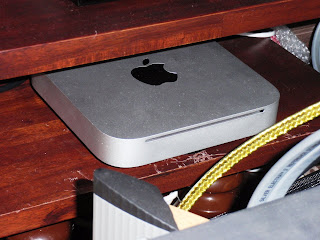 VPI Scout II turn table, and Dynavector DV20XL is one musically powerful analog combo. Note the powerful out board motor unit!
VPI Scout II turn table, and Dynavector DV20XL is one musically powerful analog combo. Note the powerful out board motor unit!VPI Industries has been making turn tables for a long, long, time. I regret that I never truly heard them at their full performance potential, until now that is. The VPI Scout II, featured here with the JMW Memorial 9 inch tone arm mounted with Dynavector DV-20XL cartridge, is the entry level of VPI turn tables. It's performance, however is anything but entry level!
It took me a little more than 2 hours of assembling the turn table and tone arm, mount plus align the cartridge, before the first tunes are being played. Before we get to the sound, I must say that the VPI is quite a heavy and solidly built turn table. There's an industrial like feel to the finishing of the whole package. The VPI Scout has four pointed isolation cone feet which are easily adjustable to keep the turn table level. The JMW Memorial tone arm is of uni pivot design, and feels right to these pair of hands and fingers. The cartridge alignment is simple to set with the VPI supplied protractor. I set the cartridge's tracking force to 2.1gsm, which is on the heavier side. I tried the anti skating device setting, but ended up preferring the sound with the device dis-engaged(this was a tip I got from Jim Smith's book, "Get Better Sound", which I'll share later). As the cartridge is low output type at 0.34mv, I set my phono stage to 72db gain setting and loaded it with 120 ohms setting. The signal from the turn table to phono stage is via a pair of VdH D-300 MKII shielded interconnects. This was the final setting which all sonic description is based on.
 Cartridge alignment is easy with the VPI supplied single point protractor.
Cartridge alignment is easy with the VPI supplied single point protractor. Tracking force is set at 2.1gsm, checked using Ortofon cartridge digital scale model DS-1.
Tracking force is set at 2.1gsm, checked using Ortofon cartridge digital scale model DS-1.From the very first LP, I knew I was in for a vinyl treat of the black arts! This turn table rocks! Literally. I found my self spinning all the rock albums in my collection dating from the 70's and 80's. This turntable has the energy and vitality to play rock albums convincingly. The treble, while not the most extended is airy and quite refined, yet never lacking in attack, should the music called for. The mids is on the rich side, rendering vocals and especially male voices a throaty quality. The female voice is not short changed either, Tsai Qin still sounds like very much her usual self on Lou Ge, rendering classic love songs very emotionally. The bass is loud, proud, but does not stand out like a sore thumb. The bass guitar is fat, full, and weighty, yet agile. It plumbs as deep as my speakers will go, and rock my listening chair gently. NOW, THIS IS WHAT I CALL BASS! Period.
With this kinda bass, how can I pass on this turn table without playing some soul and R&B LPs? I pulled out Alexander O'Neal's 1988 Christmas album, "My Gift To You", and was rewarded with sweet, sweet soul sound, especially the ever classic "Merry Christmas To You" track. I know, I know, it's not Christmas yet, but the mood's there, the music's there, and the VPI Scout just blows my mind, listening to the strong, manly vocal of Alex, harmonising with the ghostly back up guy slightly back in to the left side of the stage! Santa, I've being a very good boy this year too! Please, please make my Christmas wishes come true??? He! He!
 The Dynavector jewel box like packaging.
The Dynavector jewel box like packaging.I'm sorry, I got carried away back there. But that's just what the VPI/Dynavector combo did so, well, carry me away in to the music, all night long, every night! The sound staging properties are good, rather than great, there's width but depth perception is some what lacking. Solid imaging makes up for the short fall though. This turn table combo is also very dynamic and excitingly exuberant. It's also eerily quiet, with an extremely dark back ground and low noise. I did not find any problems with speed stability of the turn table. A special praise must go to the Dynavector DV-20XL cartridge, that for the price, this is probably the most transparent, dynamic and tonally well balanced available.
 The JMW Memorial 9 inch tone arm is of uni pivoted design, providing excellent finger and hand feel.
The JMW Memorial 9 inch tone arm is of uni pivoted design, providing excellent finger and hand feel. Note the VPI provided screw on clamp, which helps to flatten out warp disc effectively and lowers back ground noise too, making a quieter turn table. All the review sonic description is done with clamp in use.
Note the VPI provided screw on clamp, which helps to flatten out warp disc effectively and lowers back ground noise too, making a quieter turn table. All the review sonic description is done with clamp in use.So what price would you pay for this analog set up? Price break down is as follows:
1) VPI Scout II turn table(with tone arm included): RM$9900.00
2) Dynavector DV20XL cartridge: RM$1700.00
I am now looking forward towards more VPI turn tables to play with, and I've just heard the latest Classic model has a long waiting list. I can't wait to lay my hands on one of those too. He!He!
VPI is sold by Centre Circle Audio, contact Sky or Nelson at 03-77282686.












































